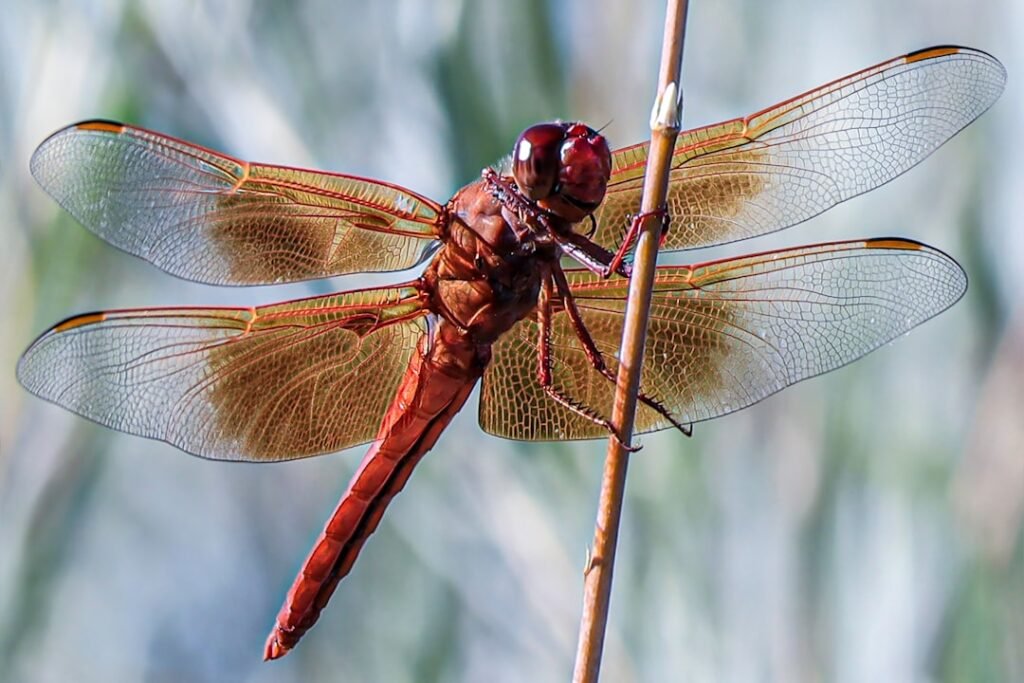Dragonflies are fascinating insects that have been around for millions of years. They belong to the order Odonata, which also includes damselflies. Dragonflies are known for their unique physical characteristics and behaviors, making them a popular subject of study and admiration among nature enthusiasts. In this blog post, we will explore the world of dragonflies and learn more about these magnificent insects.
Key Takeaways
- Dragonflies are fascinating insects that have been around for millions of years.
- Dragonflies have unique physical characteristics, including their large eyes and wings that allow them to fly in all directions.
- The life cycle of a dragonfly includes four stages: egg, larva, pupa, and adult.
- Dragonflies can be found in a variety of habitats, including ponds, lakes, and streams.
- Dragonflies are important to the ecosystem as predators and indicators of water quality.
Anatomy of a Dragonfly: Understanding the Physical Characteristics
Dragonflies have a unique body structure that allows them to fly and hunt effectively. Their bodies are divided into three main parts: the head, thorax, and abdomen. The head is equipped with large compound eyes that provide them with excellent vision. They also have a pair of strong mandibles that they use to catch and consume their prey.
One of the most distinctive features of a dragonfly is its wings. Dragonflies have two pairs of wings that are transparent and veined. These wings allow them to fly in all directions, including hovering in mid-air. Their wingspan can range from a few centimeters to over 15 centimeters, depending on the species.
Dragonflies also have six legs that are adapted for their specific lifestyle. Their legs are long and slender, allowing them to perch on plants and other surfaces. They have tiny claws at the end of each leg, which they use to grip onto their prey while feeding.
Life Cycle of a Dragonfly: From Egg to Adult
Dragonflies go through a fascinating metamorphosis from egg to adult. The life cycle of a dragonfly consists of three main stages: egg, nymph, and adult.
The female dragonfly lays her eggs in or near water, usually on plants or other surfaces above the water’s surface. The eggs hatch into nymphs, which are aquatic creatures that resemble miniature versions of the adult dragonfly. Nymphs live in the water and feed on small aquatic organisms such as insects and tadpoles.
As the nymph grows, it goes through a series of molts, shedding its exoskeleton and growing a new one. This process is called instar. The nymphs can spend several months to several years in the water, depending on the species.
When the nymph is ready to become an adult, it climbs out of the water onto a plant or other surface. It then undergoes its final molt, emerging as a fully formed adult dragonfly. The adult dragonfly has wings and can fly, and it will spend the rest of its life hunting for prey and reproducing.
Dragonfly Habitats: Where to Find These Magnificent Insects
| Dragonfly Habitats | Description | Examples |
|---|---|---|
| Lakes and Ponds | Still or slow-moving water with abundant vegetation | Lake Tahoe, Walden Pond |
| Rivers and Streams | Fast-moving water with rocky bottoms and riffles | Colorado River, Yellowstone River |
| Wetlands | Marshes, swamps, and bogs with standing water and emergent vegetation | Everglades, Okefenokee Swamp |
| Forests | Wooded areas with streams or ponds nearby | Great Smoky Mountains, Olympic National Forest |
| Deserts | Areas with intermittent streams or water sources | Sonoran Desert, Mojave Desert |
Dragonflies can be found in a variety of habitats, from ponds and lakes to forests and meadows. They are most commonly associated with freshwater habitats, as their nymphs require water to survive. However, some species of dragonflies can also be found in brackish water or even saltwater habitats.
When trying to spot dragonflies, it is important to look for areas with still or slow-moving water. Ponds, lakes, and marshes are ideal habitats for dragonflies, as they provide ample food sources and breeding grounds. Dragonflies are also attracted to areas with abundant vegetation, as they use plants as perches while hunting for prey.
In addition to freshwater habitats, dragonflies can also be found in other types of environments. Some species prefer forested areas, where they can find shade and cover. Others can be found in meadows or grasslands, where they have access to open spaces for hunting.
Dragonfly Behavior: How They Hunt, Mate, and Defend Themselves
Dragonflies have unique behaviors when it comes to hunting, mating, and defending themselves. Their hunting behavior is particularly fascinating to observe.
Dragonflies are skilled hunters and are known for their agility and speed in the air. They have excellent vision, thanks to their large compound eyes, which allows them to spot prey from a distance. Once they have spotted their prey, they will fly towards it and catch it with their strong mandibles.
Dragonflies are also known for their mating behavior. Male dragonflies will often perform elaborate courtship displays to attract females. These displays can include aerial acrobatics, hovering in front of the female, or even offering her a gift of prey.
When it comes to defending themselves, dragonflies have a few tricks up their sleeves. They are incredibly agile fliers and can quickly change direction to avoid predators. Some species of dragonflies also have bright colors or patterns on their wings or bodies, which can serve as a warning to potential predators that they are toxic or unpalatable.
The Role of Dragonflies in the Ecosystem: Why They Are Important

Dragonflies play an important role in the ecosystem, serving as both predator and prey. As predators, dragonflies help control populations of insects such as mosquitoes and flies, which can be pests to humans and other animals. They are voracious hunters and can consume large quantities of insects in a short amount of time.
Dragonflies also serve as an important food source for other animals. Birds, fish, and other insects feed on dragonflies, helping to maintain a balanced ecosystem. In addition, dragonfly nymphs play a crucial role in aquatic ecosystems by feeding on small aquatic organisms and helping to keep populations in check.
Furthermore, dragonflies are indicators of a healthy environment. They are sensitive to changes in water quality and habitat conditions, so their presence or absence can provide valuable information about the health of an ecosystem. Monitoring dragonfly populations can help scientists assess the impact of pollution or habitat destruction on the environment.
Dragonfly Species: A Look at Some of the Most Common Varieties
There are over 5,000 species of dragonflies around the world, each with its own unique characteristics and behaviors. Some of the most common varieties include the Common Green Darner, the Blue Dasher, and the Widow Skimmer.
The Common Green Darner (Anax junius) is one of the largest dragonflies in North America. It has a bright green body and blue eyes, and it is known for its long-distance migrations. The Blue Dasher (Pachydiplax longipennis) is a small dragonfly with a blue body and black markings. It is commonly found near ponds and streams and is known for its aggressive hunting behavior.
The Widow Skimmer (Libellula luctuosa) is a medium-sized dragonfly with a dark brown body and yellow markings. It is named for the black widow-like pattern on its wings. The Widow Skimmer is commonly found near marshes and wetlands and is known for its territorial behavior.
These are just a few examples of the many dragonfly species that can be found around the world. Each species has its own unique characteristics and behaviors, making them a fascinating subject of study for scientists and nature enthusiasts alike.
Dragonfly Conservation: Protecting These Beautiful Insects for Future Generations
Dragonflies are facing threats from habitat loss, pollution, and climate change. As human activities continue to impact the environment, it is important to take steps to protect these beautiful insects for future generations.
Conservation efforts can include protecting and restoring dragonfly habitats, such as wetlands and other freshwater ecosystems. This can be done through land conservation initiatives, habitat restoration projects, and the implementation of sustainable land management practices.
Reducing pollution is also crucial for dragonfly conservation. Chemical pollutants can contaminate water sources and harm dragonfly populations. By reducing the use of pesticides and other harmful chemicals, we can help create a safer environment for dragonflies and other aquatic organisms.
Climate change is another major threat to dragonflies. Rising temperatures and changes in precipitation patterns can disrupt their breeding and migration patterns. By reducing greenhouse gas emissions and promoting sustainable practices, we can help mitigate the impacts of climate change on dragonfly populations.
Dragonfly Photography: Tips and Techniques for Capturing Stunning Images
Dragonflies make great subjects for photography, but capturing them can be challenging. Here are some tips and techniques for capturing stunning images of these insects in the wild:
1. Use a telephoto lens: Dragonflies are often skittish and will fly away if you get too close. Using a telephoto lens will allow you to capture close-up shots without disturbing the insect.
2. Shoot in burst mode: Dragonflies are fast-moving creatures, so shooting in burst mode will increase your chances of capturing a sharp image. This mode allows you to take multiple shots in quick succession, increasing the likelihood of getting a clear shot.
3. Focus on the eyes: The eyes are one of the most striking features of a dragonfly. Make sure to focus on the eyes to capture their intricate details.
4. Look for interesting backgrounds: Dragonflies often perch on plants or other surfaces, providing an opportunity for interesting compositions. Look for colorful flowers or contrasting backgrounds to make your images more visually appealing.
5. Be patient: Dragonflies can be elusive and may not stay in one place for long. Be patient and wait for the right moment to capture your shot.
Dragonfly Symbolism: What These Insects Represent in Different Cultures and Traditions
Dragonflies have different meanings and symbolism in different cultures and traditions. In many cultures, dragonflies are seen as symbols of transformation, adaptability, and change. Their ability to undergo metamorphosis from egg to adult is often associated with personal growth and transformation.
In some Native American cultures, dragonflies are considered to be messengers from the spirit world. They are believed to bring messages of wisdom and guidance from ancestors and spirits.
In Japanese culture, dragonflies are seen as symbols of strength, courage, and happiness. They are often depicted in art and literature as a positive and auspicious symbol.
In Chinese culture, dragonflies are associated with prosperity and good luck. They are often depicted in traditional Chinese art and are considered to be a symbol of good fortune.
Dragonflies have also been associated with the supernatural and mystical in various cultures. In European folklore, they were believed to be witches or fairies in disguise. In some African cultures, they were seen as the spirits of the dead.
Overall, dragonflies have a rich symbolism and cultural significance in many parts of the world. They are revered for their beauty, grace, and unique characteristics, making them a beloved creature in many cultures.
In conclusion, dragonflies are fascinating insects that have captivated humans for centuries. Their unique physical characteristics, behaviors, and symbolism make them a subject of study and admiration among nature enthusiasts. Understanding their anatomy, life cycle, habitats, behavior, and conservation needs is crucial for protecting these beautiful insects for future generations. Whether you’re a photographer looking to capture stunning images or someone interested in learning more about the natural world, exploring the world of dragonflies is sure to be an exciting and rewarding experience.


